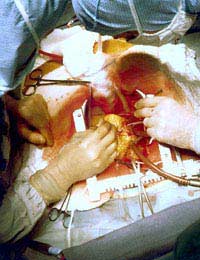What is Heart Perfusion?

Having any sort of major cardiac surgery, such as coronary artery bypass surgery, a heart valve repair operation, a heart transplant or surgery to repair damaged major blood vessels such as the aorta creates a real challenge for medicine. If the heart is being operated on directly, it can no longer push blood around the body to keep the other tissues and organs supplied with oxygen. If the brain does not get fresh blood, irreversible brain damage tends to occur from about four minutes.
The First Open Heart Operation
Today we think of a heart bypass operation as a serious procedure but one that is done as a standard operation in hospitals in the developed world. It is only since the 1950s that we have had the technology to do this though. If you were born with a congenital heart defect or had a serious valve problem in the 1940s, there was little that could be done to help you. The device that has made open heart surgery possible is the heart and lung machine. This basically takes over all of the functions of the heart and lungs during surgery and perfuses the tissues and organs of the body with fresh blood. The highly skilled medical professional that controls the heart and lung machine is called a perfusionist.The first perfusionist was Clarence Dennis, a surgeon in the US who carried out the first open heart surgery with a heart lung machine in April 1951. Unfortunately, this was not successful, not because of the heart and lung machine, but because the patient had a heart defect that was too complicated to correct. The first surgery using an external perfusion system was a heart repair on a woman of 18, also in the US, two years later.
Heart Perfusion in Action
The heart and lung machine is a highly complex piece of technology that takes incredible skill to operate, It has two main sections; an oxygenator that supplies the blood running through it with oxygen and a pump that drives the blood back through the tissues and organs of the body. The heart and lung machine is connected directly to the arteries and veins of the patient undergoing surgery and their blood supply is taken over by the machine.There is some delay in the changeover between the real heart and the heart and lung machine so, to avoid any chance of brain damage, the patients body is cooled to well below normal body temperature. This enables a slower blood flow to be used without any ill effects afterwards.


Re: Laser Surgery for Coronary Artery Disease
I was diagnosed with Idiopathic Pulmonary Fibrosis (IPF) four years ago. For over two years, I relied on…
Re: Coronary Angioplasty Surgery
My husband had a stent put in at the beginning of January. It was done at a government hospital and the doctors appointment is…
Re: Hole in the Heart: What Happens Next?
I was just in hospital with left side pain and numbness was diagnosed with hole in heart I’m home now and I’m having…
Re: Hole in the Heart: What Happens Next?
Ok I'm 61 yes old.ive been in 3 motorcycle wrecks,I have sticky platelets I've been hospitalized 3:times with blood…
Re: Why Does My Heart Beat Faster After Sweet Food?
The coffee doesn't make a heart beat faster. Caffeine makes the hart beat harder/stronger. The sugar…
Re: Hole in the Heart: What Happens Next?
Hi Doctor, My friend is having 35 years and he is having a hole in the heart, he consulted many doctors in USA and…
Re: What is Heart Block?
Hello. I have born first degree heart block. 10 years ago was temporarily changing to 2 degrees, but stay first degree. Am I at high risk…
Re: Hole in the Heart: What Happens Next?
In Sept '16 I was diagnosed with hypertension (high blood pressure) and in May '17 I had a stroke - the only symptoms…
Re: Hole in the Heart: What Happens Next?
Hi Iam 53 years old and living very healthy life. I have blood pressure but it is in normal condition with proper…
Re: What is Heart Block?
Hi there I had a pacemaker fitted last year for Mobitz II heart block. My pacemaker is set to fire if my rate drops below 60 b/pm. Am I…